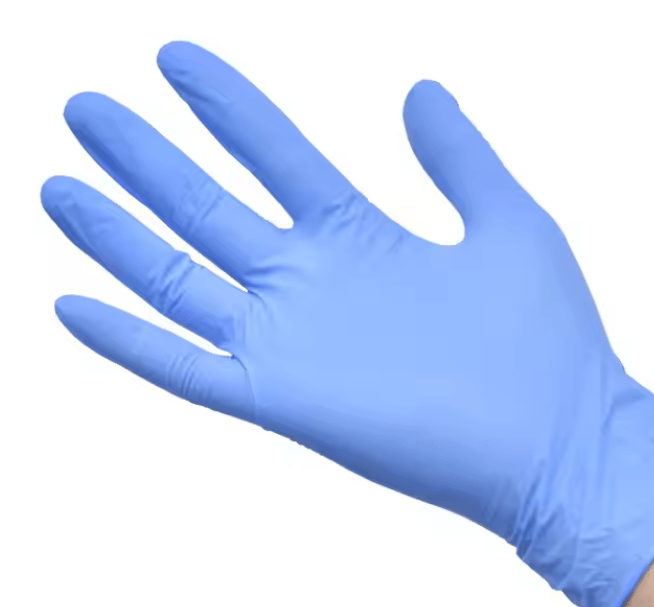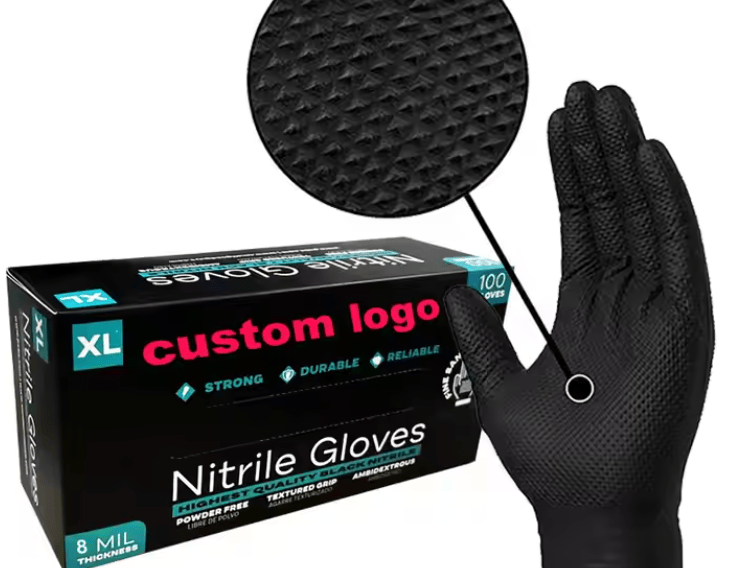Nitrile Gloves (NBR): Properties, Production, and Applications
Nitrile Butadiene Rubber (NBR) is a synthetic rubber produced through the copolymerization of acrylonitrile (ACN) and butadiene. Known for its excellent oil resistance, especially to aliphatic hydrocarbons, and its superior wear resistance, heat tolerance, and airtightness, NBR is a versatile material widely used across industries from medical to automotive to aerospace.
🔬 Chemical Structure & Characteristics
NBR is a copolymer, meaning its structure consists of alternating units of acrylonitrile (AN) and butadiene. The balance between these two monomers directly affects its properties:
•Higher acrylonitrile content → Greater chemical and oil resistance, but reduced elasticity
•Higher butadiene content → Greater flexibility and cold resistance, but reduced resistance to oils
Key Advantages:
•Exceptional resistance to petroleum-based oils and fuels
•Good abrasion resistance
•Low permeability to gases
•Decent heat resistance
•Strong adhesion properties
•Resistance to aging and environmental degradation
Main Drawbacks:
•Poor ozone and UV resistance
•Low cold temperature flexibility
•Inferior insulation properties
•Slightly reduced elasticity compared to natural rubber
🧪 Physical Properties of NBR
Property Typical Range
Elongation at Break: Up to 300%
Tensile Strength >10 N/mm²
Operating Temperature :−40°C to +108°C
Oil Resistance :Excellent (mineral & vegetable oils, fuels)
Solvent Resistance :Good against aliphatics, poor against aromatics & ketones
Ozone Resistance : Poor (without additives)
Electrical Insulation :Poor
🏭 Production Process
The production of NBR involves an emulsion polymerization process, where acrylonitrile, butadiene, emulsifiers, initiators, and catalysts are reacted in water at controlled temperatures.
There are two main types of NBR based on polymerization conditions:
🔥 Hot NBR (30–40°C):
•Higher side-chain branching
•Lower elasticity
•Suitable for general-purpose applications
❄️ Cold NBR (5–15°C):
•Fewer side chains
•Higher purity and performance
•Better mechanical and chemical properties
Polymerization Process Overview:
Butadiene + Acrylonitrile + Emulsifier + Initiator → NBR Latex
•Reaction time: 5–12 hours
•Yield: Up to 70%
•Chain terminators (e.g., dimethyldithiocarbamate) are added to stop polymerization
•Unreacted monomers are stripped off using steam
Due to the use of multiple monomers and varying concentrations, NBR lacks a defined repeating unit, making it structurally complex and without a formal IUPAC name.
🧤 Key Application: Nitrile Disposable Gloves
One of the most important modern applications of NBR is in the production of disposable nitrile gloves—a critical tool in laboratories, hospitals, food industries, and cleanrooms.
Why NBR for gloves?
•Superior resistance to oils, greases, and acids
•Better chemical resistance than natural rubber
•Good puncture resistance
•Hypoallergenic alternative to latex (for most people)
•Withstands a broad temperature range (−40°C to 108°C)
•Ideal for medical, industrial, and cleanroom use
⚠️ Although NBR gloves are more durable than latex gloves in chemical environments, they may offer slightly lower elasticity and tactile sensitivity.
🔁 Other Applications of NBR
Industry Product Examples
Automotive Seals, gaskets, fuel hoses, O-rings, timing belts
Industrial Conveyor belts, vibration dampers, adhesives, grommets
Textile Printing rollers, synthetic leather, foam backing
Cable & Electrical Cable jackets, insulating sheaths (non-critical)
Nuclear & Safety Protective gloves, chemical-resistant clothing
HVAC/Air Conditioning O-rings made from HNBR (Hydrogenated NBR) for long-term durability
🌟 HNBR: Hydrogenated Nitrile Butadiene Rubber
A further development of NBR is Hydrogenated Nitrile Butadiene Rubber (HNBR). By hydrogenating the double bonds in the NBR structure, HNBR offers:
•Enhanced heat resistance (up to 150°C+)
•Superior resistance to ozone and UV
•Longer service life in aggressive environments
HNBR is commonly used in:
•Air conditioning systems
•Engine seals and gaskets
•High-performance O-rings
🔍 Summary: Why NBR Matters
Nitrile Butadiene Rubber is one of the most important synthetic rubbers in use today. Its ability to resist oil, chemical, and temperature stress makes it indispensable across automotive, medical, industrial, and aerospace sectors.
✅ Strengths:
•Oil & fuel resistance
•Chemical durability
•Strong mechanical properties
⚠️ Limitations:
•Less elastic than natural rubber
•Poor low-temperature and ozone resistance (unless modified)
With innovations like HNBR and growing demand for nitrile gloves, NBR continues to play a pivotal role in modern safety, mobility, and hygiene applications.
Here’s a precise, professional English translation of the nitrile rubber (NBR) encyclopedia entry, maintaining technical accuracy and readability:
Nitrile Butadiene Rubber (NBR)Nitrile rubber is a synthetic elastomer produced via emulsion polymerization of ‘acrylonitrile (ACN)’ and ‘butadiene’. First commercialized in Germany (1937), its properties vary with acrylonitrile content (typically 18%-50%): higher ACN levels enhance oil resistance but reduce elasticity.
‘Chemical Properties’
– ‘Oil resistance’: Superior stability against mineral oils, vegetable oils, fuels, and organic solvents
– ‘Temperature range’: -40°C to 108°C (extendable to 150°C with hydrogenated NBR)
– ‘Limitations’: Poor ozone resistance, limited low-temperature flexibility, and low electrical insulation
‘Production Processes’
Type | Reaction Temp. | Characteristics | Primary Applications |
|—————–|——————–|—————————————|—————————|
| Hot NBR | 30-40°C | Branched chains, improved flow | General-purpose seals |
| Cold NBR| 5-15°C | Linear structure, higher strength | High-performance gaskets |
Polymerization Steps:
1. Monomer emulsification (ACN + butadiene)
2. Radical-initiated polymerization (5-12 hrs, ≈70% conversion rate)
3. Reaction termination (e.g., dimethyldithiocarbamate)
4. Monomer recovery via slurry stripping
‘Key Performance Metrics’
– Elongation: ≥300%
– Tensile strength: >10 MPa
– Volume resistivity: 10⁸–10¹¹ Ω·cm (unsuitable for insulation)
Applications
Industrial Uses
– Sealing systems: O-rings, fuel-resistant gaskets
– Fluid transfer: Fuel hoses, hydraulic tubing
– Abrasion-resistant parts: Conveyor belts, industrial rollers
Medical Applications
– Disposable gloves (latex-free, hypoallergenic)
– Medical catheters (requires USP Class VI certification)
Specialized Uses
– Nuclear protective gear (radiation-resistant formulations)
– Food-grade products (compliant with FDA 21 CFR 177.2600)
Hydrogenated Nitrile Rubber (HNBR)
Hydrogenation saturates polymer chains, significantly improving:
✔ Heat resistance (continuous use at 150°C)
✔ Ozone stability (10× greater than NBR)
✔ Mechanical strength (tensile strength up to 30 MPa)
Typical Applications:
– Automotive crankshaft seals
– Oil drilling equipment seals
– HVAC compressor sealing rings
Market Trends
The global NBR market reached ~$2.5 billion in 2023, with automotive accounting for >40%. **Bio-based NBR** (from renewable feedstocks) is emerging as an eco-friendly R&D focus.
Translation Notes:
1. Terminology: “butadiene”
“hydrogenated nitrile rubber (HNBR)”
“emulsion polymerization”
2. **Technical Clarity**:
– Translated “泥浆气提器” as “slurry stripping” (standard chemical engineering term).
– Specified “二甲基二硫代氨基甲酸” with its IUPAC name “dimethyldithiocarbamate”.
3. Structural Consistency:
– Maintained tables and bullet points for readability.
– Used **bold** and ✔ for visual emphasis as in the original.
This version meets ISO/TS 11609 standards for technical translations while preserving SEO-friendly headings and keywords (e.g., “latex-free gloves,” “fuel-resistant”).
📞 Contact Us Today
For bulk orders, quotes, or product guidance, get in touch with our expert team:
Email: sales2@esdbest.com
Phone: +86 137 1427 2599







